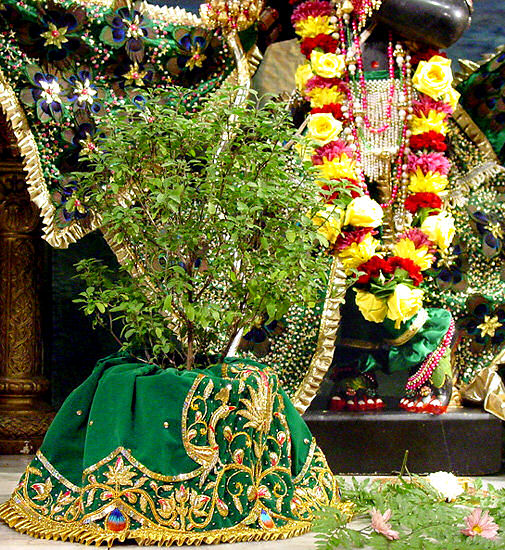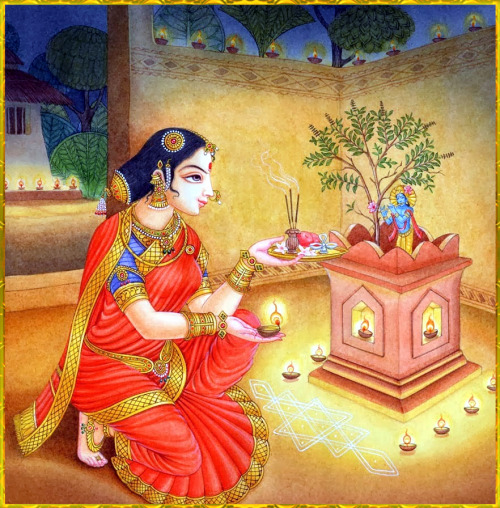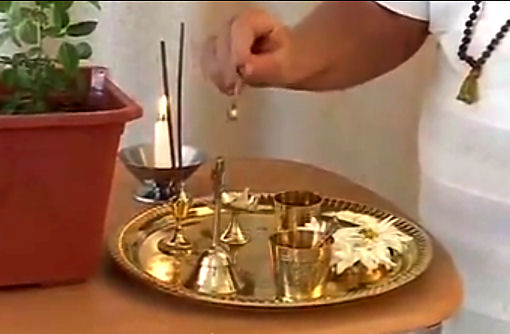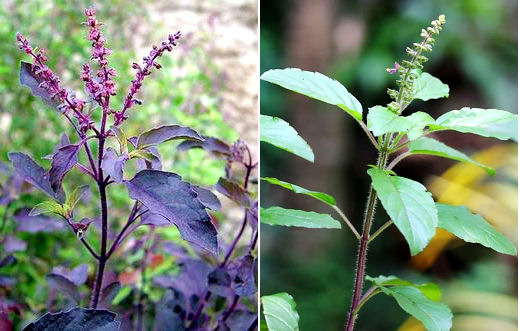Tulasī-mantras for worshipping Tulasī-devī
Śrīla Prabhupāda: I am giving you herewith three mantras for Tulasī Devī as follows:
vṛndāyai tulasī-devyai / priyāyai keśavasya ca
viṣṇu-bhakti-prade devī / satya vatyai namo namaḥ
This is offering OBEISANCES, bowing down (pancanga pranam). And when COLLECTING LEAVES from the plant, the following mantra should be chanted:
tulasy amṛta-janmāsi / sadā tvaṁ keśava-priya
keśavārthaṁ cinomi tvāṁ / varadā bhava śobhane
Then the mantra FOR CIRCUMAMBULATING the Tulasi tree:
yāni kāni ca pāpāni / brahma-hatyādikāni ca
tāni tāni praṇaśyanti / pradakṣiṇaḥ pade pade
So there are three mantras, one for bowing down, one for circumambulating, and one for collecting the leaves. The collecting of leaves should be done once in the morning for worshiping and for putting on the plates of foodstuff to be offered. On each bowl or plate there should be at lest one leaf. So you follow and practice these Tulasi affairs and you try to distribute your experience to all the other centers, that will be a new chapter in the history of Krsna Consciousness Movement. (Letter to Govinda dasi)

The worship of Śrīmatī Tulasī in the Temple
Immediately following Maṅgala-āratī, Tulasi-puja is offered. The devotees sing prayers to Tulasī-devī while one devotee offers Her ārati, then all circumambulate Tulasī-devī, offering her water. Preferably, ārati should also be offered to Tulsi in the evening, just before Sandhyā-āratī.
Begin Tulasi-arati by offering obeisances to Tulasīi-devī, chanting the Tulasī-Praṇāma mantra three times.
Śrī Tulasī Praṇāma
vṛndāyai tulasī-devyai / priyāyai keśavasya ca
viṣṇu-bhakti-prade devī / satya vatyai namo namaḥ
vṛndāyai—unto Vṛndā; tulasī-devyai—unto Tulasī Devī priyāyai- who is dear; keśavasya—to Lord Keśava; ca—and; viṣṇu-bhakti- devotional service to Lord Viṣṇu/ Kṛṣṇa; prade—who bestows; devi-O goddess; satyavatyai—unto Satyavatī; namo namaḥ—repeated obeisances.
I offer my repeated obeisances unto Vṛndā, Śrīmatī Tulasī-devī, who is very dear to Lord Keśava. O goddess, you bestow devotional service to Lord Kṛṣṇa and you possess the highest truth.
Next, the devotees sing Śrī Tulasī Kīrtana while one devotee offers ārati to Tulasī-devī with incense, a ghee lamp and flowers. While offering the articles, the devotee offering Tulasi-arati should stand on a mat (āsana) and ring a bell with the left hand. Just as when offering other āratis, the hands and paraphernalia should be purified (ācamana) with water from pancha-patra. After offering each item, they may be distributed to the devotees.
Śrī Tulasī-Kīrtana
namo namaḥ tulasī kṛṣṇa-preyasi namo namaḥ
rādhā-kṛṣṇa-sevā pābo ei abilāṣī
ye tomāra śaraṇa loy, tara vāñchā pūrṇa hoy
kṛpā kori’ koro tāre vṛndāvana-vāsi
mora ei abhilāṣa, vilāsa kuñje dio vāsa
nayana heribo sadā yugala-rūpa-rāśi
ei nivedana dhara, sakhīra anugata koro
sevā-adhikāra diye koro nīja dāsī
dīna kṛṣṇa-dāse koy, ei yena mora hoy
śrī-rādhā-govinda-preme sadā yena bhāsi
(1) O Tulasī, beloved of Kṛṣṇa, I bow before you again and again. My desire is to obtain the service of Śrī Śrī Rādhā and Kṛṣṇa.
(2) Whoever takes shelter of you has his wishes fulfilled. Bestowing your mercy on him, you make him a resident of Vṛndāvana.
(3) My desire is that you will also give me a residence in the pleasure groves of Śrī Vṛndāvana-dhāma. Thus within my vision I will always behold the beautiful pastimes of Rādhā and Kṛṣṇa.
(4) I beg you to make me a follower of the cowherd damsels of Vraja. Please give me the privilege of devotional service and make me your own maidservant.
(5) This very fallen and lowly servant of Kṛṣṇa prays, “May I always swim in the love of Śrī Śrī Rādhā and Govinda.
When Tulasī-pūjā Kīrtana song is finished, the devotees circumambulate Śrīmate Tulasī-devī at least four times, offering her water by pouring some at her root. (Water is only offered in the morning, not evening.) Use small spoons to help avoid over watering Her. While circumambulating, chant the Śrī Tulasī Pradakṣiṇa mantra.
Śrī Tulasī Pradakṣiṇa Mantra
(Sing while circumambulating Tulasī)
yāni kāni ca pāpāni / brahma-hatyādikāni ca
tāni tāni praṇaśyanti / pradakṣiṇaḥ pade pade
yāni kāni—whatever; ca—and; pāpāni—sins; brahma-hatya—killing of a brāhmaṇa; ādikāni—and so on; ca—also; tāni tāni—all of them; praṇaśyanti—are destroyed; pradakṣiṇaḥ—(by) the circumambulation (of Tulasī Devī); pade pade—at every step
Those who circumambulate Śrīmatī Tulasī-devī step by step destro whatever sins they have committed, even the killing of a brāhmaṇa.
Have the words to the Tulasī ārati prayers typed and posted so guests can see them. Encourage all guests to participate in Tulasi-arati. With a little encouragement, they will join in and enjoy themselves. The devotees should always bow down when they see Taulasi-devi, and others will follow in showing her respect.
Tulasī-devī should be kept in a special pot, and the pot should sit upon a stand, up off the floor. When carrying a potted Tulasī plant, it is traditional to honor Her by carrying the pot on one's head. If it's too heavy, carry the pot out in front. For worship, the stand Tulasī-devī sits on should be high enough so the base of the plant is above the waist of the devotee offering ārati. If it is not possible to keep a live Tulasī plant, one may offer worship to a picture of Tulasī-devī.
For one who is Tulasī's servant, that responsibility enters into all the different aspects of Her existence. You must see that She is being maintained properly, that Her leaves are always offered in a clean and fresh manner, and that all the devotees are given the opportunity to worship Her. Make Tulasī-devī some skirts to fit around Her pot, particularly when She is being offered ārati. If Tulasī is very close to, or on the altar, make sure that no candles or ghee lamps are placed close enough to burn her leaves. Use incense sparingly as it tends to make Her sick if burned continually. Garlands left for more than a day will mold and attract bugs, so if Tulasī is nearby, she will be affected.
While in Detroit, Śrīla Prabhupāda asked, "Where is Tulasī?". When She was brought in, Śrīla Prabhupāda put His garland around Her and had Her placed on the altar, saying "Mother Tulasī is so kind. Treat Her as you would any of Kṛṣṇa's pure devotees."

HOW TO PLUCK & USE TULSI LEAVES FOR OFFERINGS TO KRISHNA?
One should be clean before touching or plucking Tulasi. The Vayu Purana says that one who picks Tulasi without having bathed and then performs worship is an offender, and all his activities becomes useless.
With your right hand, carefully pick the tulasi leaves or soft tulasi-manjaris, along with their stems-one at a time-while repeatedly chanting the tulasi-cayana-mantra:
tulasy amṛta-janmāsi / sadā tvaṁ keśava-priyā
keśavārthaṁ cinomi tvāṁ varadā bhava śobhane
"O Tulasī of effulgent beauty, you were born from nectar, during the churning of the milk ocean. You are always very dear to Lord Keśava. Now, in order to worship Lord Keśava, I am collecting your leaves and mañjarīs. Please bestow your benediction on me that my worship will obtain success."
Take special care to avoid causing Śrīmatī Tulasī-devī any pain. If when picking Tulasi leaves one breaks the branches, Visnu feels pain in His heart. Pluck her leaves with your right hand while holding the branch in your left, taking care not to break it. Do not use scissors or a knife to cut the leaves from the plant. When finished, recite the ksama-prarthana-mantra, begging her pardon:
cayanodbhava-duḥkhaṁ ca / yad hṛdi tava vartate
tat kṣamasva jagan-mātaḥ / vṛndā-devī namo ’stu te
O Tulasī-devī, I offer my respectful obeisances unto you. Kindly forgive me if I have caused you pain by picking your leaves and manjaris, O mother of the universe.
Do not pluck Tulasī leaves in the morning before daylight or in the evening after dark, nor at any time on Dvadasi-tithi, the day following Ekadasi. Even if the tulasi leaves have become dry because they were cut on the previous day or in the morning, they may still be used in Deity worship.
AVOID PLUCKING TULSI LEAVES ON DWADASI
Tulasi should not be plucked on dvadasi. The Visnu Dharmottara says, Vaisnavas should never pick Tulasi on dvadasi tithi.
samkranty Adau ni Siddho'pi tulasyavacayah smrtau
param zrI viznu bhaktastu dvadazyam eva nesyate
"It is generally forbidden to pluck Tulasi on Sankranti, (Purnima, Amavasya, Dvadashi, Sunday) etc., according to the strict rules of the Smritis, but the most important rule (according to Shrila Sanatana Goswami) which the Vaishnava devotees should certainly follow is to not pluck Tulasi leaves on Dvadashi." (From Hari Bhakthi Vilasa 7.353)
nac chindat tulasim vipra
dvādaśyaṁ vaiṣṇavaḥ kvacit
"Oh brahmanas, a Vaisnava never picks Tulasi leaves on Dvadashi, (the day after Ekadashi)."
Why should we avoid plucking Tulasi leaves on Dvadasi?
Srimati Tulsi Maharani, the pure devotee of the Lord, keeps fasting on the whole Ekadashi and takes rest on Dwadashi. So the devotee in order to not to disturb or hurt her, don't pluck leaves on that day.
Then what to do to get the Tulsi leaves for offering on Dwadashi and other purposes?
Follow advance savings. Keep some advance Tulsi leaves for Dwadashi for offering purposes. Or , one may pick the leaves fallen on the ground around the pot and then after thoroughly washing it, can use it for offering.
Mantra when offering Tulasī leaves to Lord Kṛṣṇa
etat tulasī patram klīṁ kṛṣṇāya namaḥ

There are two types of Tulasī:
1. Kṛṣṇa Tulasī: This has purple colouring in the leaves and stems
2. Rāma Tulasī: This has green leaves and stems.
Both of these Tulasī are used in the worship of Lord Kṛṣṇa.
How-to-perform-Tulasī-Pūja
While this song is being sung by all the devotees gathered the offering of the ceremony simultaneously goes on. The paraphernalia [as shown in “Paraphernalia for performing Arati”] should be offered as follows

https://www.youtube.com/watch?v=PZtXQY5mL6o&feature=related
1) Perform achamana to purify the hands, [that is holding spoon in left hand first, one flick of water into the left hand to purify. Then with left hand put 3 drops of water into the right hand and say “Om Keshavaya Namah” sipping half of the water and the other half thrown on the ground. Repeat this step 2 more times saying “Om Narayanaya Namah” and “Om Madhavaya Namah” respectively.
2) Purify the Blowing Conchshell by pouring water from the Lota on it [there should be a bowl underneath to catch the water or if not that at least a cloth near by for wipe the floor at the end.]. The holding the Conch in either one’s right hand or both hands blow into to it 3 long blows and then rinse the conch again with water from the Lota. Once the conch has been blown the singing begins.
3) There should already be a candle lit separately for lighting the incense and ghee lamp.
Holding the spoon from the Achaman cup in the right hand do one right flick of water [to purify the right hand] then place three drops of water on the bell [bell should be held in one’s left hand and be rung continuously through the offering of paraphernalia] then hold in left hand then with right hand light the incense sticks [either the number 1, 3 or 5] and then place 3 drops of water on the incense sticks. Then in a circular motion moving the hand clockwise one should wave the incense aroundthe picture ofSrila Prabhupada on the Vyasasanaand then the Tulasi plant, after that offer 3 big circles around the audience.
4) Once this is done one should again blow the blowing Conch according to step 2. After this is done one should water the floor near the altar to clean any spilt water in the offering process and then offer full flat prostrated obeisances in front of the altar from left to right while reciting Srila Prabhupada’s pranama mantra
5) The arati paraphernalia should be taken to the kitchen for washing and cleaning.
6) Step 3 should be repeated for the remaining 2 items namely the ghee lamp and fragrant flowers [either1, 3 or 5] respectively.
7) There are a few things to be noted: a) Before Tulasi is brought in the temple room for worship the curtain on the Pancha Tattva altar is closed. A table should be place in the middle of the temple room b) As the Tulasi plant is brought into the room and place of the table the audience says “Srimati Tulasi maharani ki jaya” [All Glories to the topmost queen Srimati Tulasi] the devotees all bown down by offering half obeisances with head touching the floor. The devotee who will be leading the Kirtana loudly recites the “Tulasi Pranama Mantra” [as mentioned above] 3 times with the audience responding loudly each time c) After the conch is blown signaling the beginning of the arati the“Tulasi Kirtana” begins, when the pujari[ devotee who offers the ceremony] completes it the lead singer begins to recite the “Tulasi prayer” [as mentioned above] 3 times. While this is going on the devotees in the audience come up to the Tulasi plant and purifying the right hand with a right flick of water into the right proceed to offer 3 drops of water from the achamana cup at the root of the Tulasi plant d) after the “Tulasi Kirtana” has been chant thrice by the lead singer he then breaks into the Hare Krishna mantra at leats 3 time or until all the audience has offer Tulasi 3 drops of water. The lead chanter then finishes of by chanting Jaya Vrnda-devi! Jaya Tulasi Maharani and Jaya Prabhupada! with the audience.
« NEXT »


